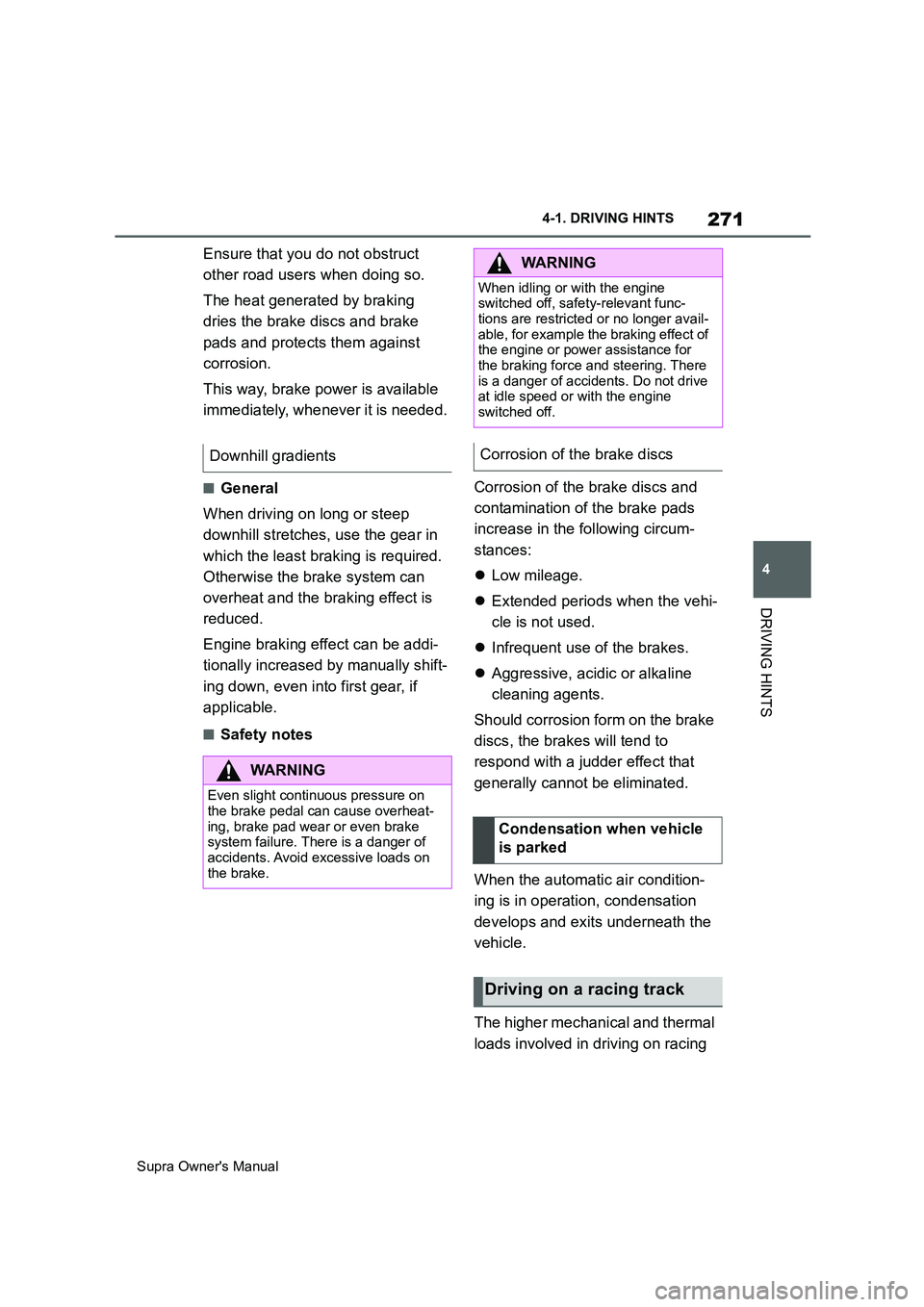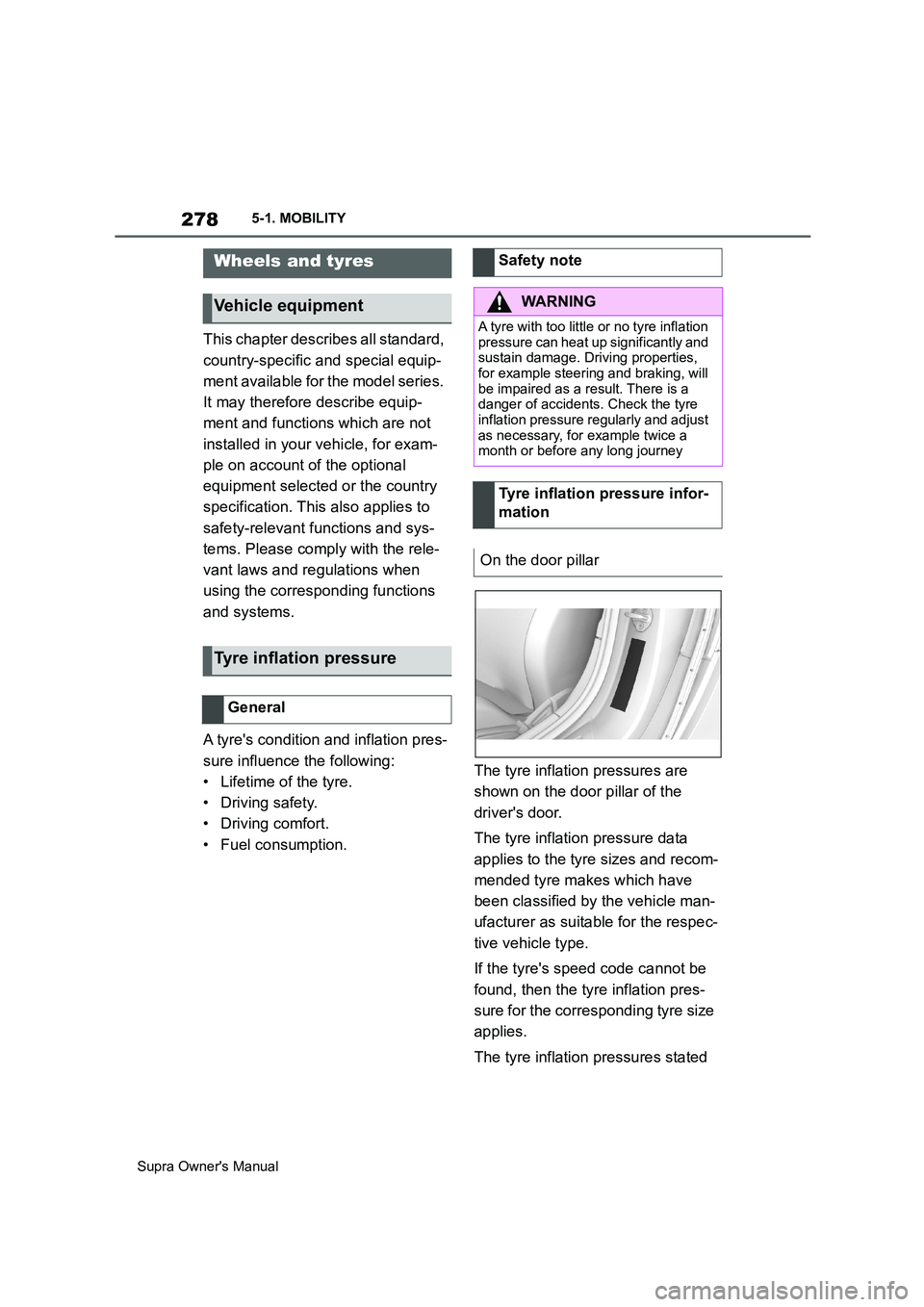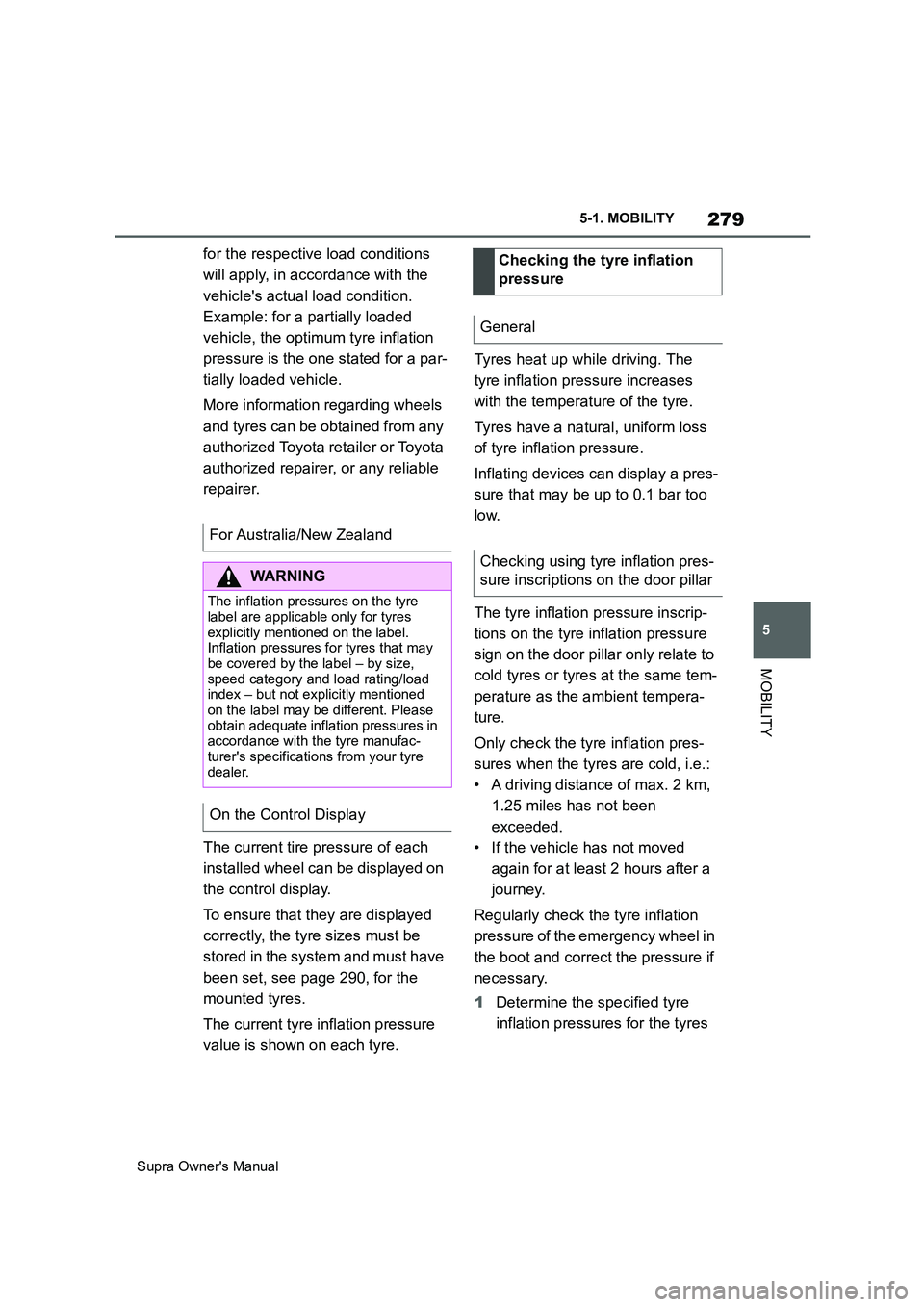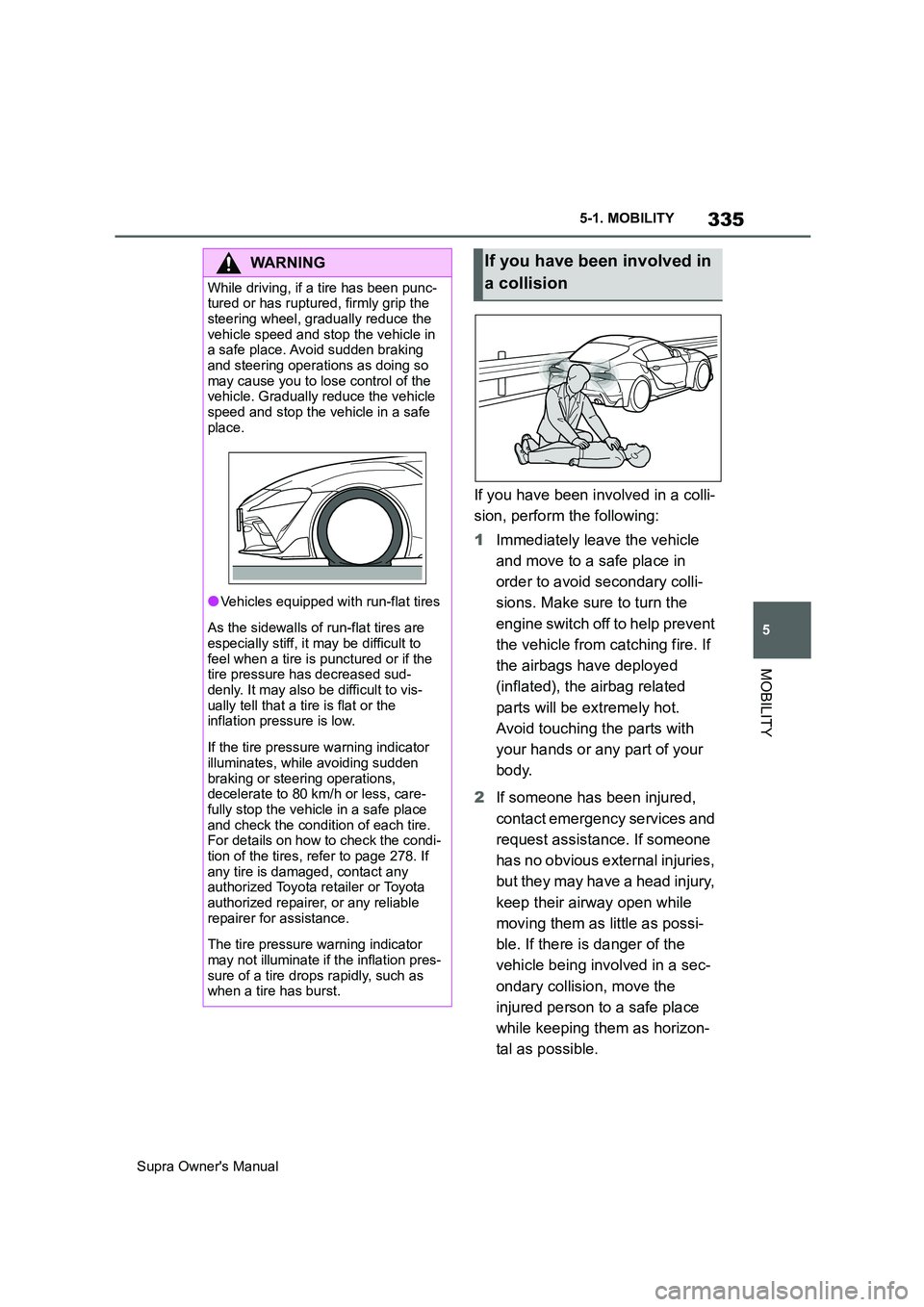2019 TOYOTA SUPRA air condition
[x] Cancel search: air conditionPage 271 of 456

271
4
Supra Owner's Manual4-1. DRIVING HINTS
DRIVING HINTS
Ensure that you do not obstruct
other road users when doing so.
The heat generated by braking
dries the brake discs and brake
pads and protects them against
corrosion.
This way, brake power is available
immediately, whenever it is needed.
■General
When driving on long or steep
downhill stretches, use the gear in
which the least braking is required.
Otherwise the brake system can
overheat and the braking effect is
reduced.
Engine braking effect can be addi-
tionally increased by manually shift-
ing down, even into first gear, if
applicable.
■Safety notesCorrosion of the brake discs and
contamination of the brake pads
increase in the following circum-
stances:
Low mileage.
Extended periods when the vehi-
cle is not used.
Infrequent use of the brakes.
Aggressive, acidic or alkaline
cleaning agents.
Should corrosion form on the brake
discs, the brakes will tend to
respond with a judder effect that
generally cannot be eliminated.
When the automatic air condition-
ing is in operation, condensation
develops and exits underneath the
vehicle.
The higher mechanical and thermal
loads involved in driving on racing Downhill gradients
WARNING
Even slight continuous pressure on
the brake pedal can cause overheat-
ing, brake pad wear or even brake
system failure. There is a danger of
accidents. Avoid excessive loads on
the brake.
WARNING
When idling or with the engine
switched off, safety-relevant func-
tions are restricted or no longer avail-
able, for example the braking effect of
the engine or power assistance for
the braking force and steering. There
is a danger of accidents. Do not drive
at idle speed or with the engine
switched off.
Corrosion of the brake discs
Condensation when vehicle
is parked
Driving on a racing track
Page 278 of 456

278
Supra Owner's Manual5-1. MOBILITY
This chapter describes all standard,
country-specific and special equip-
ment available for the model series.
It may therefore describe equip-
ment and functions which are not
installed in your vehicle, for exam-
ple on account of the optional
equipment selected or the country
specification. This also applies to
safety-relevant functions and sys-
tems. Please comply with the rele-
vant laws and regulations when
using the corresponding functions
and systems.
A tyre's condition and inflation pres-
sure influence the following:
• Lifetime of the tyre.
• Driving safety.
• Driving comfort.
• Fuel consumption.The tyre inflation pressures are
shown on the door pillar of the
driver's door.
The tyre inflation pressure data
applies to the tyre sizes and recom-
mended tyre makes which have
been classified by the vehicle man-
ufacturer as suitable for the respec-
tive vehicle type.
If the tyre's speed code cannot be
found, then the tyre inflation pres-
sure for the corresponding tyre size
applies.
The tyre inflation pressures stated
Wheels and tyres
Vehicle equipment
Tyre inflation pressure
General
Safety note
WARNING
A tyre with too little or no tyre inflation
pressure can heat up significantly and
sustain damage. Driving properties,
for example steering and braking, will
be impaired as a result. There is a
danger of accidents. Check the tyre
inflation pressure regularly and adjust
as necessary, for example twice a
month or before any long journey
Tyre inflation pressure infor-
mation
On the door pillar
Page 279 of 456

279
5
Supra Owner's Manual5-1. MOBILITY
MOBILITY
for the respective load conditions
will apply, in accordance with the
vehicle's actual load condition.
Example: for a partially loaded
vehicle, the optimum tyre inflation
pressure is the one stated for a par-
tially loaded vehicle.
More information regarding wheels
and tyres can be obtained from any
authorized Toyota retailer or Toyota
authorized repairer, or any reliable
repairer.
The current tire pressure of each
installed wheel can be displayed on
the control display.
To ensure that they are displayed
correctly, the tyre sizes must be
stored in the system and must have
been set, see page 290, for the
mounted tyres.
The current tyre inflation pressure
value is shown on each tyre.Tyres heat up while driving. The
tyre inflation pressure increases
with the temperature of the tyre.
Tyres have a natural, uniform loss
of tyre inflation pressure.
Inflating devices can display a pres-
sure that may be up to 0.1 bar too
low.
The tyre inflation pressure inscrip-
tions on the tyre inflation pressure
sign on the door pillar only relate to
cold tyres or tyres at the same tem-
perature as the ambient tempera-
ture.
Only check the tyre inflation pres-
sures when the tyres are cold, i.e.:
• A driving distance of max. 2 km,
1.25 miles has not been
exceeded.
• If the vehicle has not moved
again for at least 2 hours after a
journey.
Regularly check the tyre inflation
pressure of the emergency wheel in
the boot and correct the pressure if
necessary.
1Determine the specified tyre
inflation pressures for the tyres For Australia/New Zealand
WARNING
The inflation pressures on the tyre
label are applicable only for tyres
explicitly mentioned on the label.
Inflation pressures for tyres that may
be covered by the label – by size,
speed category and load rating/load
index – but not explicitly mentioned
on the label may be different. Please
obtain adequate inflation pressures in
accordance with the tyre manufac-
turer's specifications from your tyre
dealer.
On the Control Display
Checking the tyre inflation
pressure
General
Checking using tyre inflation pres-
sure inscriptions on the door pillar
Page 283 of 456

283
5
Supra Owner's Manual5-1. MOBILITY
MOBILITY
Due to the manufacturing process,
new tyres do not provide maximum
grip immediately.
Drive moderately for the first 300
km, 200 miles.
The manufacturer of your vehicle
advises against the use of
retreaded tyres.
Winter tyres are recommended if
driving in winter conditions.
Although so-called all-season tyres
with an M+S label have better win-
ter characteristics than summer
tyres, they do not normally match
the performance of winter tyres.
If winter tyres are fitted, observe
and do not exceed the respectively
permitted maximum speed.For your own safety, only use
run-flat tyres. There is no spare
wheel available in the event of a
breakdown. Additional information
is available from any authorized
Toyota retailer or Toyota authorized
repairer, or any reliable repairer.
Swapping the front wheels with the
rear wheels or vice versa is not per-
mitted on vehicles with different tyre
or rim dimensions on the front and
rear axles.
Do not exceed the maximum tyre
inflation pressure indicated on the
tyre's side wall.
Store wheels and tyres in a cool,
dry and dark place when not in use.
Protect the tyres against contami-
nation from oil, grease and sol-
vents.
Do not leave tyres in plastic bags.
Remove dirt from the wheels or
tyres. New tyres
Retreaded tyres
WARNING
Retreaded tyres may have different
tyre carcasses. Their durability may
be reduced with increasing age.
There is a danger of accidents. Do
not use retreaded tyres.
Winter tyres
General
Maximum speed of winter tyres
Replacing run-flat tyres
Swapping over front and rear
wheels
Storing tyres
Tyre inflation pressure
Tyre storage
Page 332 of 456

332
Supra Owner's Manual5-1. MOBILITY
SymbolMeaning
VSC Vehicle Stability Con-
tro lSystem
Parking brake
Air conditioning
Defrost the windscreen and
remove condensation
Blower motor, Interior venti-
lation
Rear window heating
Seat heating
Seat setting
Crash-security module
Switching center column,
Light switch element, steer-
ing Operating panel Audio
HiFi amplifier, Video module
TV
Rear-view mirror
Overhead function center,
Exterior door handle elec-
tronics
Instrument cluster
Additional battery: Dual
Accumulator System (DSS)
Fuel pump control electron-
ics, Natural Vacuum Leak
Detection, Gas generator for
battery safety terminal,
Remote control receiver
Electric window opener
Heating and air-condition-
ing system
Vehicle's diagnostic port
(interface)
Interior lights in the boot
Vertical Dynamic platform
Vertical Dynamic platform
Vertical Dynamic platform
Mono Camera (Kafas)
Head Unit
Active Sound Design
USB Hub
Body Domain Controller
SymbolMeaning
Page 335 of 456

335
5
Supra Owner's Manual5-1. MOBILITY
MOBILITY
If you have been involved in a colli-
sion, perform the following:
1Immediately leave the vehicle
and move to a safe place in
order to avoid secondary colli-
sions. Make sure to turn the
engine switch off to help prevent
the vehicle from catching fire. If
the airbags have deployed
(inflated), the airbag related
parts will be extremely hot.
Avoid touching the parts with
your hands or any part of your
body.
2If someone has been injured,
contact emergency services and
request assistance. If someone
has no obvious external injuries,
but they may have a head injury,
keep their airway open while
moving them as little as possi-
ble. If there is danger of the
vehicle being involved in a sec-
ondary collision, move the
injured person to a safe place
while keeping them as horizon-
tal as possible.
WARNING
While driving, if a tire has been punc-
tured or has ruptured, firmly grip the
steering wheel, gradually reduce the
vehicle speed and stop the vehicle in
a safe place. Avoid sudden braking
and steering operations as doing so
may cause you to lose control of the
vehicle. Gradually reduce the vehicle
speed and stop the vehicle in a safe
place.
●Vehicles equipped with run-flat tires
As the sidewalls of run-flat tires are
especially stiff, it may be difficult to
feel when a tire is punctured or if the
tire pressure has decreased sud-
denly. It may also be difficult to vis-
ually tell that a tire is flat or the
inflation pressure is low.
If the tire pressure warning indicator
illuminates, while avoiding sudden
braking or steering operations,
decelerate to 80 km/h or less, care-
fully stop the vehicle in a safe place
and check the condition of each tire.
For details on how to check the condi-
tion of the tires, refer to page 278. If
any tire is damaged, contact any
authorized Toyota retailer or Toyota
authorized repairer, or any reliable
repairer for assistance.
The tire pressure warning indicator
may not illuminate if the inflation pres-
sure of a tire drops rapidly, such as
when a tire has burst.
If you have been involved in
a collision
Page 337 of 456

337
5
Supra Owner's Manual5-1. MOBILITY
MOBILITY
1"Connected Serv."
2"Toyota Supra Assistance"
3"Roadside assistance"
A voice connection is established.
The system can be used to trigger
an emergency call automatically or
manually in emergency situations.
Press the SOS button in an emer-
gency only.
The emergency call establishes a
connection to a public emergency
call number.
This depends on factors such as
the specific mobile telephone net-
work and the national regulations.
The emergency call is placed using
the SIM card integrated in the vehi-
cle and cannot be switched off.
For technical reasons, it might not
be possible to make an emergency
call in highly adverse conditions.Standby state is switched on.
Emergency call system is func-
tional.
If the vehicle is equipped with
automatic emergency call: the
SIM card integrated in the vehi-
cle is activated.
In certain circumstances, for exam-
ple deployment of the airbags, an
emergency call may be placed
automatically immediately after an
accident of corresponding severity.
An automatic emergency call is not
influenced by pressing the SOS
button.
1Tap on cover flap.
Emergency call (except for
Russia)
Statutory emergency call
Principle
General
Overview
SOS button.
Operating requirements
Automatic triggering
Manual triggering
Page 338 of 456

338
Supra Owner's Manual5-1. MOBILITY
2Press and hold the SOS button
until the LED in the button area
is illuminated green.
The LED is illuminated green
when the emergency call has
been activated.
If a cancellation request is displayed on
the Control Display, the emergency call
can be cancelled.
If the situation permits, wait in the vehi-
cle until voice contact has been estab-
lished.
The LED flashes green when the
connection to the emergency
number has been established.
In the case of an emergency call, data
is sent to the public rescue coordination
centre in order to decide what rescue
measures are required. The data may
include, for example, the current posi-
tion of the vehicle, if this can be deter-
mined.
Information about data transfer and
saving, see page
12.
Even if you can no longer hear the res-
cue coordination centre through the
loudspeakers, the rescue coordination
centre may still be able to hear you
speak.
The rescue coordination centre
ends the emergency call.
The emergency call function may
be impaired.
The LED in the emergency call but-
ton area illuminates for approx. 30
seconds. A vehicle message is shown.
Have a check performed by an any
authorized Toyota retailer or Toyota
authorized repairer, or any reliable
repairer.
The system can be used to trigger
an emergency call automatically or
manually in emergency situations.
Press the SOS button in an emer-
gency only.
The automatic emergency call sys-
tem establishes a connection with
the Toyota emergency call centre.
Even if no emergency call through
Toyota emergency call centre is
possible, in some cases an emer-
gency call may still be established
to a public emergency call number.
This depends on factors such as
the specific mobile telephone net-
work and the national regulations.
For technical reasons, it might not
be possible to make an emergency
call in highly adverse conditions.
Malfunction
Automatic emergency call
Principle
General